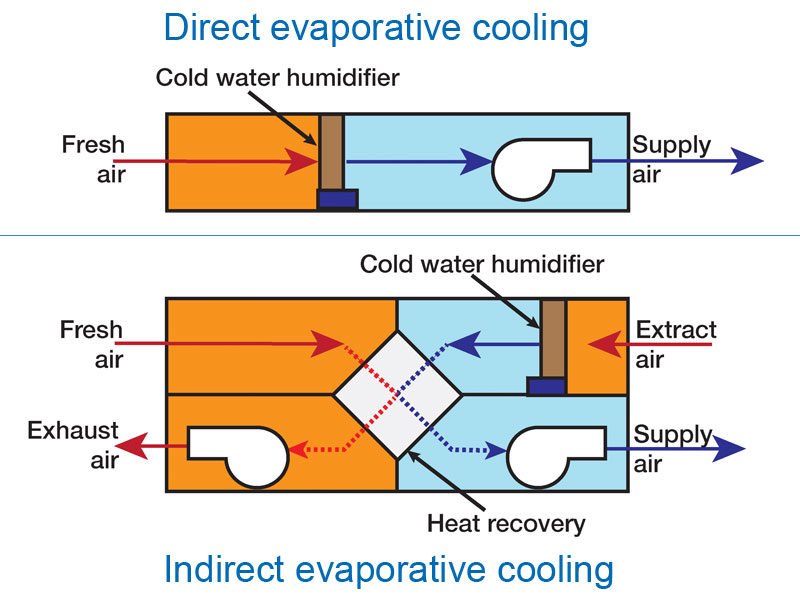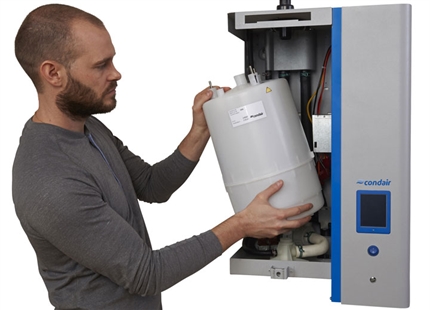
Author: Carl Batchelor, OEM & Business Development Manager, Condair plc
Data Centre Humidification
The use of humidifiers in data centres has undergone considerable change in recent years. From the early computers which used punched cards that needed humidification to maintain the physical properties of the card to magnetic tape data storage that needed a level of humidity to prevent dust and debris adhering to the reels.
As technology has moved on so has the need for data centre humidification. The main reason to humidify data halls has been to combat electrostatic discharge (ESD) that can damage sensitive electronics. However, servers have now evolved to minimise the risk of damage from ESD, reducing the need for humidification of data halls.
This led ASHRAE (American Society of Heating, Refrigerating and Air-Conditioning Engineers) to change its recommended guidelines on the acceptable lower level of humidity in data centres in 2008. Previously the recommended humidity level included a minimum of 40%RH (relative humidity) but was reduced and is now measured in dew point rather than relative humidity as studies suggested absolute humidity has a greater impact on ESD. The new recommended lower limit is a line from 18°C dry bulb temperature and 5.5°C dew-point temperature to 27°C dry-bulb temperature and a 5.5°C dew-point temperature. Over this range of dry-bulb temperatures and a 5.5°C dew point, the recommended RH varies from approximately 25% to 45%.
This loosening of the ASHRAE guidelines made the use of low energy "free air cooling" systems more practical...
The reduction in the minimum recommended humidity level has resulted in a fewer number of hours per year when humidification (and its associated energy use) to combat ESD is necessary. However, humidification is still needed in winter months, when cold outside temperatures result a very low internal humidity and increase the potential risks from ESD.
Traditionally electrode boiler steam humidifiers incorporated in the CRAC (Computer Room Air Conditioning) units have been used to combat ESD in data centres. However, this type of humidifier has a high energy consumption and maintenance requirement, giving it a high overall operating cost. More recently, low energy cold water humidifiers have been used in innovative energy saving strategies.
For instance, in 2008 the Fujitsu data centre in North London employed spray humidifiers to prevent ESD by preheating the cold, saturated, fresh air to 30°C with heat recovered from the data halls. Heating the incoming air allowed it to absorb more moisture and after humidification with the low energy JetSpray humidifier, it was returned to a room supply temperature of 17°C at an optimum 50% ±10%RH. The energy cost saving of using a JetSpray humidifier combined with heat recovery, compared to a steam humidifier was around £35,000 per year.
A cold water humidifier will provide around 680W of cooling for every 1kg of moisture it evaporates...
The change in the ASHRAE guidelines for environmental control included an expansion of the recommended temperature window, from 20-25°C to 18-27°C and an increase in the maximum humidity level from 55%RH to 69%RH and 15°C dew point. This loosening of the guidelines made the use of low energy “free air cooling” systems more practical in data centre environments. Fresh air brought in from outside is used to provide cooling rather than compressor driven CRAC units. In a UK climate this type of cooling can maintain a data hall environment to the recommended levels for around 70% of the year.
Alongside the use of free air cooling systems, humidification took on a different role within the data centre environment. A cold water humidifier will provide around 680W of cooling for every 1kg of moisture it evaporates and can operate on as little as 550W while providing up to 840kg/hr. By supplementing free air cooling systems with evaporative cooling from cold water humidifiers, the use of free air cooling systems can be extended from 70% of the year to 95%, reducing the reliance on compressor driven cooling to just 5% of the year – the very hottest days.
There are two types of evaporative cooling using cold water humidifiers – direct and indirect. Direct evaporative cooling sees the humidifier providing moisture to the incoming air, increasing its humidity while decreasing its temperature. Indirect evaporative cooling is when the humidifier operates on the exhaust air. Before being expelled, the air is humidified and cooled, then passed through a heat recovery unit to transfer the cool thermal energy to the incoming air. This cools the incoming air without adding any additional moisture.
Packaged heat recovery AHUs are starting to be manufactured with this type of innovative indirect evaporative cooling technology incorporated. The AHU passes the return air through an evaporative humidifier, humidifying the air and cooling it by several degrees. The AHU’s heat recovery unit then transfers a percentage of this temperature drop to the incoming fresh air reducing the load on energy hungry chillers. Other packaged AHUs using evaporative humidifiers in a direct evaporative cooling capacity have been able to achieve up to 12°C cooling from the humidifier when used in data centre environments in hot climates.
The efficiency of a data centre is measured in what is called the Power Useage Effectiveness (PUE), which is a ratio of the energy consumed by the servers compared to the energy consumption of other services such as the lights, cooling equipment, etc. If a data centre has a PUE of 2.0, then for every kW used by the servers another kW is being used by the other services within the data centre. Ideally the PUE should be as close to 1.0 as possible. The revised ASHRAE guidelines and the resulting adoption of free air cooling have resulted in many modern data centres being built with a greatly reduced PUE.
Although the revised guidelines have reduced the need to humidify to combat ESD, the use of humidifiers in data centres has actually increased as a result. Low energy cold water humidifiers are not only delivering energy efficient humidification in cold winter months but are helping reduce PUE in warmer months when free air cooling alone doesn’t deliver enough cooling to satisfy the demand.
















